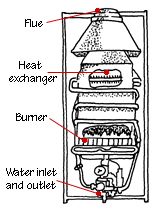|
Newer "tankless" water heaters heat and deliver water on demand, without storing it. Rather than holding water in a tank, they circulate it through a series of burners or electric coils that heat the water as it passes through.
Though tankless units cost more than most conventional water heaters, they're cheaper to operate because energy isn't required to maintain a large tank of hot water 24 hours a day. Because the water heater doesn't store hot water, it never runs out-- unless, that is, the flow surpasses the unit's ability to heat it. If two people take separate showers at the same time, a tankless unit may not be able to handle the flow. Start the washing machine and they're in for a cool shower. Although a conventional water heater delivers water at a set temperature, the output water temperature of most tankless units is dependent upon both the flow and the temperature of incoming water, which can vary greatly from one season or region to another. Capacity of a tankless water heater is measured by how many degrees it increases water temperature at a given flow, typically expressed in gallons per minute (gpm).
Gas-fired tankless water heaters do require venting--in fact, their flues generally must be larger than those required for conventional gas water heaters. Like conventional water heaters, some units have power vents that allow you to exhaust gasses out a side wall; these are ideal for replacing electric water heaters where venting out the roof would be costly. |
|
|
Get Pre-Screened Water Heater Installation Help in Your Area! Copyright 2011, HomeTips, LLC. All rights reserved. Reproduction without permission is prohibited. |
|
| Related search terms: new tankless water heaters, tankless hot water heaters, on demand water heater, home tank less water heater, under sink water heater |
|
|

 Because of the heat output and response time required, most (but not all) whole-house tankless heaters are gas-fired (including propane and kerosene). Smaller, single-fixture units, which may store a few gallons of water, are usually electric.
Because of the heat output and response time required, most (but not all) whole-house tankless heaters are gas-fired (including propane and kerosene). Smaller, single-fixture units, which may store a few gallons of water, are usually electric.